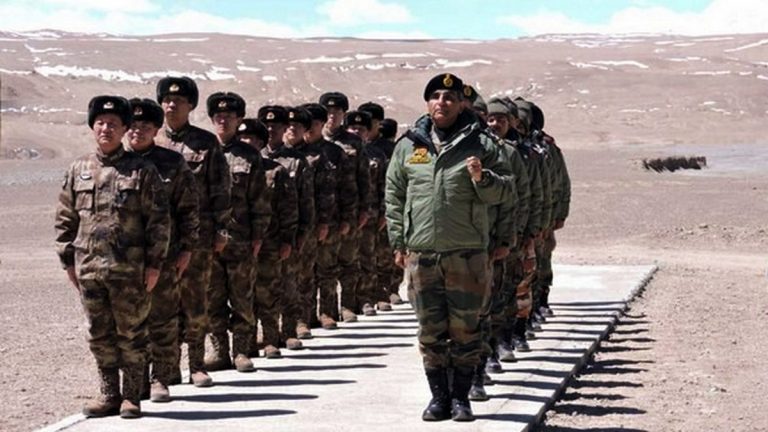
SOURCE: THE PRINT
Unprecedented tensions between Indian and Chinese forces along the border in eastern Ladakh continue to fester with both sides bolstering their troop deployment resulting in “stand off” in at least three locations. With China bringing in a large number of Border Defence Regiment (BDR) troops along the Line of Actual Control (LAC) to force the Border Roads Organisation (BRO) to stop infrastructure-development activities, India has decided to stay “dug in” and conduct “mirror deployment”, ThePrint has learnt.
Mirror deployment means India is matching any move of the Chinese with their own.
The border in Ladakh has been tense since earlier this month, the tensions precipitated by Chinese objections to Indian construction activity within Indian territory. The two sides have also been challenging each other’s patrols daily.
Since the first reports of a scuffle along the Pangong Lake (two-thirds of which is controlled by China) on 5 May, three standoff points have reportedly emerged in eastern Ladakh amid Chinese attempts to stake claim over them.
The Chinese have not only moved in additional troops, but also brought in more boats into the lake and vehicles on the road last week. They have also built bunkers, sources said.
This is backed by helicopters for aerial vigil in the troubled zone in the Galwan Valley, besides infrastructure development to house and cater to the additional troops.
Amid these tensions, Army chief General M.M. Naravane made a quiet visit to Ladakh Friday, where he is said to have “reviewed” the developing situation.
‘Troop build-up in Galwan valley a worry’
There are two areas where the tensions has risen – at the Pangong lake and 200 kms away in the Galwan Valley.
The August 5 scuffle, which left several soldiers injured, took place at the lake.
The lake’s northern bank juts forward like a palm with 8 protrusions, which are identified as “fingers” to demarcate territory. While India asserts that the Line of Actual Control (LAC) starts at Finger 8, the Chinese claim it starts at Finger 2.
Sources told The Print that the Chinese have built blocking points at Finger 2 to stop the Indian patrols from going further. They have also objected to Indian construction activity in the Galwan valley, even though China has itself carried out extensive road-laying activities on its side of the LAC.
India’s current construction activity in the area relates to laying of roads and bridges connecting the Shyok-DBO road, inaugurated last year, to forward areas.
Sources in the security establishment told ThePrint that the Chinese have brought in several companies of their BDR, a paramilitary organisation, into various locations along the Galwan valley, where India is constructing a bridge over a nullah or rivulet, near the confluence of the Shyok and Galwan rivers, about 200 km north of the Pangong lake
While India believes its territory extends a few kilometres beyond the bridge, the Chinese say it gives the Indian forces entry into what they see as their territory, the sources said.
Increased Chinese troop movement in the Galwan valley, the sources added, is meant to pressure the Indian authorities. They described it as a worry.
The Chinese have about 13 BDR regiments in this area. Asked about the exact number of troops brought forward by the Chinese, the sources said they couldn’t say exactly. However, they indicated that even if a company each from all the regiments is brought forward, the numbers would be about 1,200-1,300 men.
The Chinese have rapidly spread the area of confrontation along a span of at least 3-4 km. As reported by ThePrint, at least 80 tents have come up in the area to house the increased troop deployment.
Sources said while talks are on between established channels on both sides, there is no question of forgoing the infrastructure development at the LAC, which is being taken up on a priority basis.
The Army is already reinforcing the forward deployment of troops with more men and material. According to sources, the Army is conducting a “mirror deployment”.
One of the issues with deployment in this area, which is about 14,000 feet, is that soldiers have to be acclimatised first. So, soldiers in reserve areas are being used and reserves are being filled in.
Sources said the situation in Galwan valley is surprising and unprecedented because the LAC is almost agreed upon at the local level and not many transgressions have been reported in recent years.
However, no maps have been exchanged between the two sides with respect to this area.
While the Chinese are now claiming part of the area as their territory, Indian forces have provided records of their patrols to specific points in the past to stress their claim.
India historically never recorded patrols, but decided to do so around 10 years ago after finding it hard to counter the Chinese tactic of presenting records to prove that they patrolled a particular point and it was their area.
https://defencenewsofindia.com/stand-off-in-ladakh-army-matching-wits-with-china-on-every-step/






